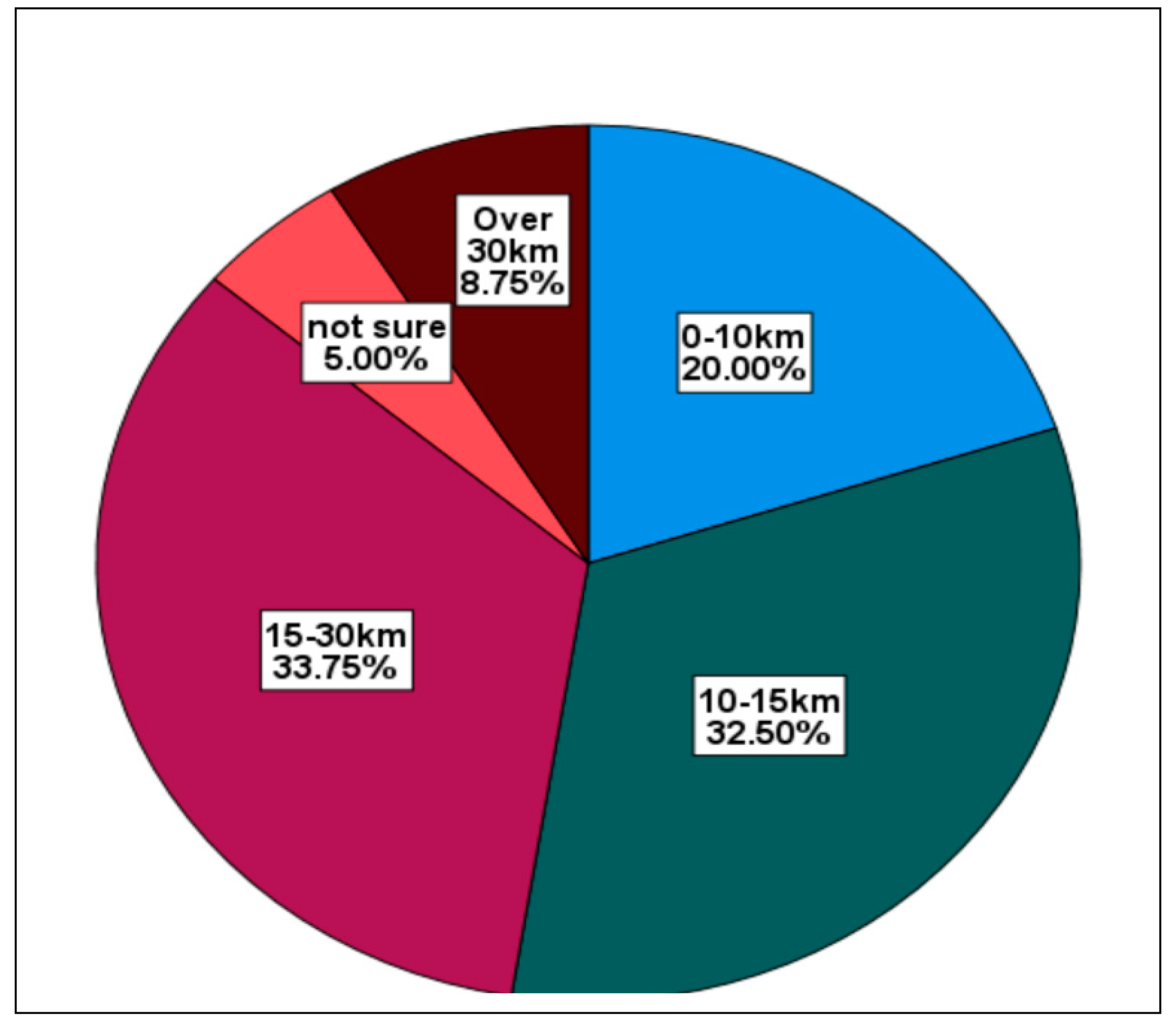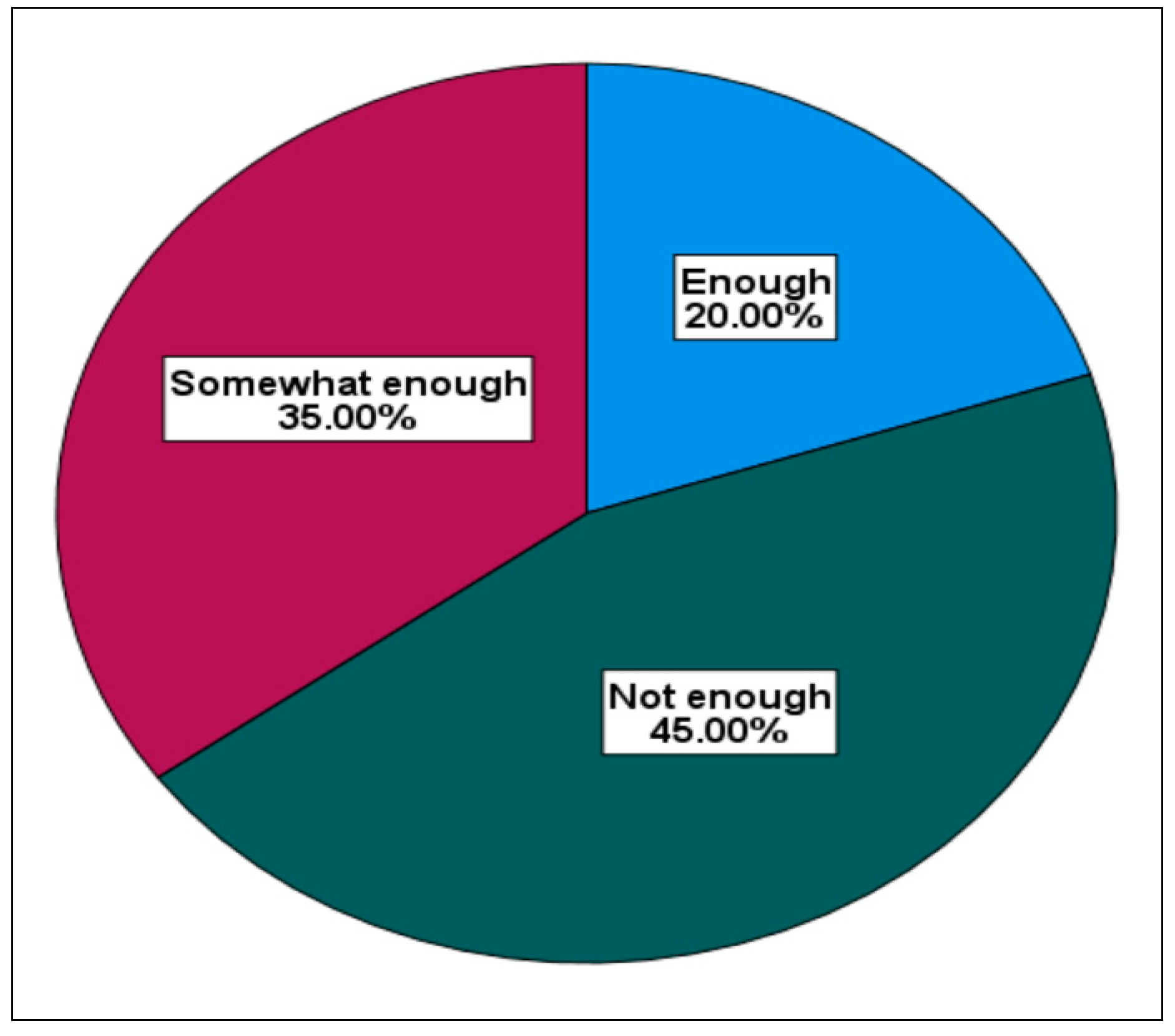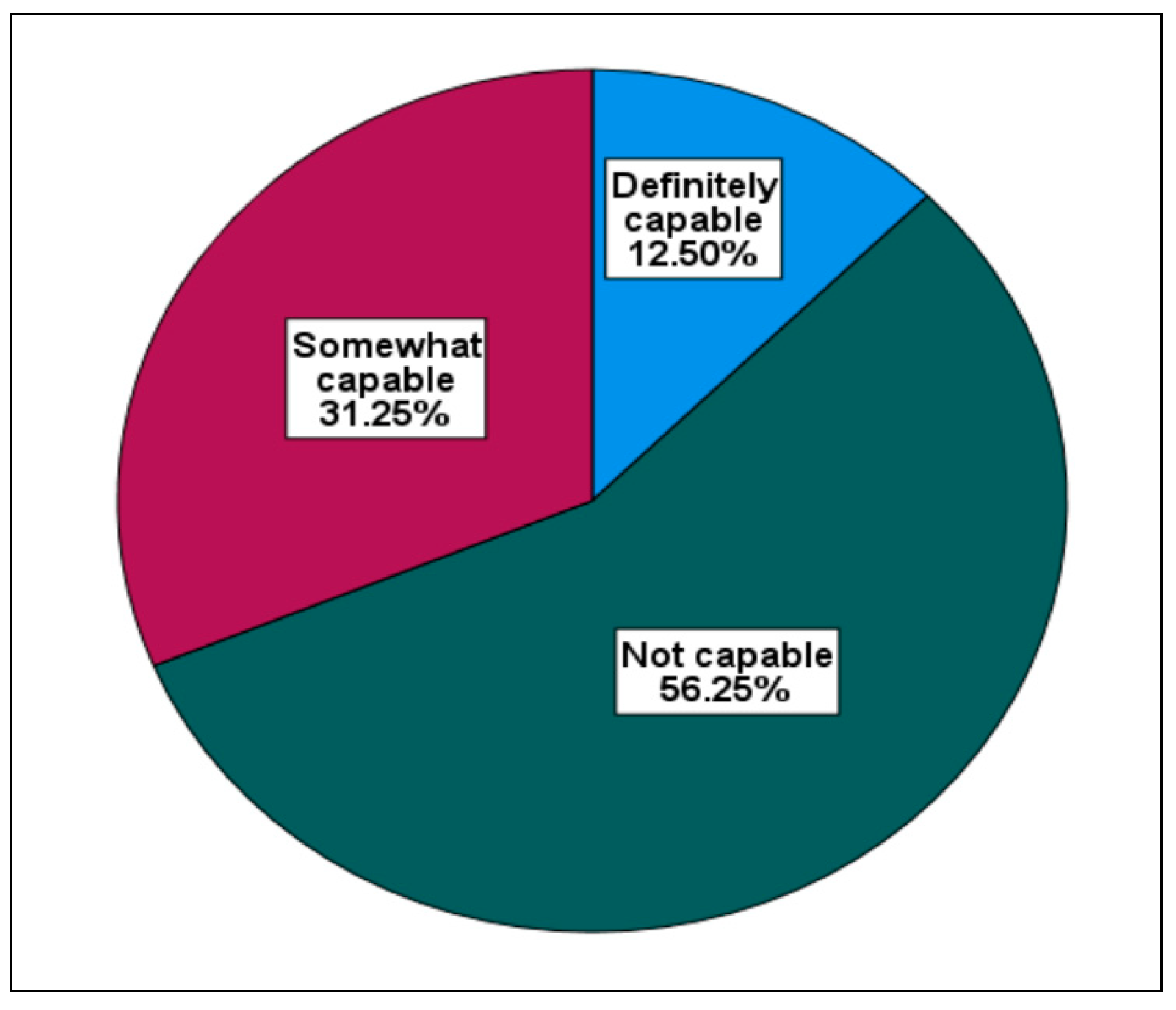Assessing Public Perceptions on Coastal Access -Community Profile: A Case Study of Ngqushwa Local Municipality, South Africa
Abstract
1. Introduction
2. Background for Using Community Profiles to Evaluate Coastal Access
3. Importance of Evaluating Public Perceptions in Integrated Coastal Zone Management
4. Study Site Description
5. Materials and Methods
6. Results
6.1. Demographic Profile
6.2. Perceptions of the Communities
6.2.1. Coastal Communities’ Importance Ranking Perspectives
6.2.2. Frequency and Purpose of Visiting the Coast
6.2.3. Distance to the Coast by Community Members
6.2.4. Coastal Infrastructure
6.2.5. Views about the Coastal Safety and Security
6.2.6. Community Views about the Possible Limitations in Accessing the Coastline
6.2.7. Community Awareness about Coastal Policies
6.2.8. Community Engagement in Coastal Management Matters
6.2.9. The Capacity of a Local Municipality
6.3. Cross Tabulation Results
7. Discussion
8. Conclusions
Author Contributions
Funding
Institutional Review Board Statement
Informed Consent Statement
Data Availability Statement
Conflicts of Interest
References
- Haynes, R.W.; Graham, R.T.; Quigley, T.M. A Framework for Ecosystem Management in the Interior Columbia Basin and Portions of the Klamath and Great Basins; Pacific Northwest Research Station: Portland, OR, USA, 1996. [Google Scholar]
- Groot, R.S.; Wilson, M.A.; Boumans, R.M. A Typology for the Classification Description and Valuation of Ecosystem Functions, Goods and Services. Ecol. Econ. 2002, 41, 393–408. [Google Scholar] [CrossRef]
- Daily, G.C. (Ed.) Nature’s Services. Societal Dependence on Natural Ecosystems; Island Press: Washington, DC, USA, 1997. [Google Scholar]
- Coastal Zone Canada Association. Baseline. Paper Prepared for the CZC2000 Conference. CZCA, Bedford Institute of Oceanography, Dartmouth, Canada. 2000. Available online: http://www.dal.ca/aczisc/czcaazcc/contact_e.htm (accessed on 17 July 2021).
- Visser, L. The social-institutional dynamics of coastal zone management. J. Coast. Conserv. 1999, 5, 145–148. [Google Scholar] [CrossRef]
- Nichols, K. Coming to terms with “Integrated Coastal Management”: Problems of meaning and method in a new arena of resource regulation. Prof. Geogr. 1999, 51, 388–399. [Google Scholar] [CrossRef]
- Yet, M.; Manuel, P.; DeVidi, M.; MacDonald, B.H. Learning from experience: Lessons from community-based engagement for improving participatory marine spatial planning. Plan. Pract. Res. 2002, 37, 189–212. [Google Scholar] [CrossRef]
- Carless, R. Public Perceptions and Knowledge of Coastal Management on the Manhood Peninsula, West Sussex. Coastnet Research Report. November 2010. Available online: https://www.chichester.gov.uk/media/14117/Coastal-literacy-final-report/pdf/coastal-literacy-report_standard.pdf (accessed on 20 June 2021).
- UNCED. Agenda 21. United Nations Conference on Environment and Development, Rio de Janeiro. 1992. Available online: http://www.un.org/esa/sustdev/documents/agenda21/ (accessed on 21 July 2021).
- Jefferson, R.; McKinley, E.; Capstick, S.; Fletcher, S.; Griffin, H.; Milanese, M. Understanding audiences: Making public perceptions research matter to marine conservation. Ocean. Coast. Manag. 2015, 115, 61–70. [Google Scholar] [CrossRef]
- Famuditi, T.O. Developing Local Community Participation within Shoreline Management in England: The Role of Coastal Action Groups. Ph.D. Thesis, University of Portsmouth, Portsmouth, UK, 2016. [Google Scholar]
- Ernsteins, R. Editorial: Participation and Integration Are Key to Coastal Management. DG Environment News Alert Service of the European Commission. Science for Environmental Policy. 2010. Available online: https://ec.europa.eu/environment/integration/research/newsalert/pdf/19si_en.pdf (accessed on 26 November 2021).
- Schmidt, L.; Gomes, C.; Guerreiro, S.; O’Riordan, T. Are we all on the same boat? The challenge of adaptation facing Portuguese coastal communities: Risk perception, trustbuilding and genuine participation. Land Use Policy 2014, 38, 355–365. [Google Scholar] [CrossRef]
- Parvin, G.A.; Ahsan, R.; Shaw, R. Chapter: Community Based Coastal Zone Management in Bangladesh. In Communities and Coastal Zone Management; Shaw, R., Krishnamurthy, R.R., Eds.; Research Publishing Services: Singapore, 2010; pp. 165–184. ISBN 978-981-08-2141-8. [Google Scholar]
- Quesada, G.C.; Klenke, T.; Mejía-Ortíz, L.M. Regulatory Challenges in Realizing Integrated Coastal Management—Lessons from Germany, Costa Rica, Mexico and South Africa. Sustainability 2018, 10, 3772. [Google Scholar] [CrossRef]
- McNally, C.G.; Gold, A.; Pollnac, R.; Kiwango, H. Stakeholder Perceptions of Ecosystem Services of the Wami Riverand Estuary. Ecol. Soc. 2016, 21, 34. Available online: https://www.ecologyandsociety.org/vol21/iss3/art34/ (accessed on 22 June 2021).
- Alessa, L.; Bennett, S.M.; Kliskey, A.D. Effects of knowledge, personal attribution and perception of ecosystem health on depreciative behaviors in the intertidal zone of Pacific Rim National Park and Reserve. J. Environ. Manag. 2003, 68, 207–218. [Google Scholar] [CrossRef]
- Wouter, K. Current Status of Public Participation in ICZM. 2019. Available online: http://www.coastalwiki.org/wiki/Current_status_of_public_participation_in_ICZM (accessed on 19 March 2022).
- Williams, A.T.; Micallef, A. Beach Management: Principles and Practice; EarthScan: London, UK, 2009; ISBN 978-1-84407-435-8. [Google Scholar]
- Bosch, E.R. Bringing Public Perceptions in the Integrated Assessment of Coastal Systems: Case Studies on Beach Tourism and Coastal Erosion in Western Mediterranean, Institute of Environmental Science and Technology. Ph.D. Thesis, Institute of Environmental Science and Technology-AUB, Barcelona, Spain, 2008. [Google Scholar]
- Potts, T.; Pita, C.; O’Higgins, T.; Mee, L. Who cares? European attitudes towards marine and coastal environments. Mar. Policy 2016, 72, 59–66. [Google Scholar]
- Morgan, R.; Gatell, E.; Junyent, R.; Micallef, A.; Ozhan, E.; Williams, A.T. Pilot studies of Mediterranean Beach user perceptions. In Proceedings of the International Workshop on MED & Black Sea ICZM, Sarigerme, Turkey, 2–5 November 1996; Ozhan, E., Ed.; pp. 99–109. [Google Scholar]
- Breton, F.; Clapes, J.; Marques, A.; Priestley, G.K. The recreational use of beaches and consequences for the development of new trends in management: The case of the beaches of the Metropolitan Region of Barcelona (Catalonia, Spain). Ocean. Coast. Manag. 1996, 32, 153–180. [Google Scholar] [CrossRef]
- Villares, M.; Roca, E.; Serra, J.; Montori, C. Social perception as a tool for beach planning: A case study on the Catalan Coast. J. Coast. Res. 2006, 48, 118–123. [Google Scholar]
- Koutrakis, E.; Sapounidis, A.; Marzetti, S.; Marin, V.; Roussel, S.; Martino, S.; Fabiano, M.; Paoli, C.; Rey-Valette, H.; Povh, D.; et al. ICZM and coastal defence perception by beach users: Lessons from the Mediterranean coastal area. Ocean. Coast. Manag. 2011, 54, 821–830. [Google Scholar] [CrossRef]
- Roca, E.; Villares, M.; Ortego, M.I. Assessing public perceptions on beach quality according to beach users’ profile: A case study in the Costa Brava (Spain). Tour. Manag. 2009, 30, 598–607. [Google Scholar] [CrossRef]
- Williams, A.T.; Gardner, W.; Jones, T.C.; Morgan, R.; Ozhan, E. A psychological approach to attitudes and perceptions of beach users: Implications for coastal zone management. In The first international conference on the Mediterranean coastal environment. Medcoast 1993, 93, 217–228. [Google Scholar]
- Santos, I.R.; Friedrich, A.C.; Wallner-Kersanach, M.; Fillmann, G. Influence of socio-economic characteristics of beach users on litter generation. Ocean. Coast. Manag. 2005, 48, 742–752. [Google Scholar] [CrossRef]
- Silva, C.P. Landscape perception and coastal management: Methodology to encourage public participation. J. Coast. Res. 2006, 39, 930–934. [Google Scholar]
- De Ruyck, A.M.C.; Soares, A.G.; McLachlan, A. Factors Influencing Human Beach Choice on Three South African Beaches: A Multivariate Analysis. Springer 1995, 36, 345–352. [Google Scholar] [CrossRef]
- Ibrahim, H.S.; Hegazy, I.R. The Effect of Participation on the Integrated Coastal Zone Management (ICZM) Effectiveness: The Egyptian Experience. In Proceedings of the 10th International Conference on the Mediterranean Coastal Environment, MEDCOAST, Rhodes, Greece, 25–29 October 2011; Available online: https://www.researchgate.net/publication/283055977_The_effect_of_particition_on_the_Integrated_Coastal_Zone_Management_ICZM_effectiveness_The_Egyptian_experience/link/57cfd9bc08ae582e0694aad6/download (accessed on 18 March 2022).
- Cihar, M.; Stankova, J. Attitudes of stakeholders towards the Podyji/Thaya River Basin National Park in the Czech Republic. J. Environ. Manag. 2006, 81, 273–285. [Google Scholar] [CrossRef]
- Priskin, J. Tourist perceptions of degradation caused by coastal nature-based recreation. Environ. Manag. 2003, 32, 189–204. [Google Scholar] [CrossRef]
- Ramsar Convention Secretariat. Wise use of wetlands: A Conceptual Framework for the wise use of wetlands. In Ramsar Handbooks for the Wise Use of Wetlands, 3rd ed.; Ramsar Convention Secretariat: Gland, Switzerland, 2007; Volume 1. [Google Scholar]
- Anderson, S.S. Public Perceptions of Coastal Resources in Southern California. Urbac Coast. 2012, 3, pp. 36–47. Available online: Anderson2012UrbanCoast_publicopinionpoll(1).pdf (accessed on 22 April 2022).
- Bennett, N. Marine Social Science for the Peopled Seas. Coast. Manag. 2019, 47, 244–252. [Google Scholar] [CrossRef]
- Statistic South Africa. 2016. Available online: http://cs2016.statssa.gov.za/wp-content/uploads/2016/07/NT-30-06-2016-RELEASE-for-CS-2016-_Statistical-releas_1-July-2016.pdf (accessed on 10 August 2021).
- Ngqushwa Local Municipality. Integrated Development Plan. 2021. Available online: S45C-920060815120(ngqushwamun.gov.za) (accessed on 25 November 2021).
- Amathole District Municipality. Coastal Management Programme, EOH Coastal and Environmental Services. 2016. Available online: http://www.cesnet.co.za/pubdocs/Amatole%20District%20Muni%20AHun300816_251/Final%20Amathole%20DM%20CMP%20Full.pdf (accessed on 22 March 2022).
- Ngqushwa Local Municipality. Coastal Management Plan; EOH Coastal and Environmental Services: Makhanda, South Africa, 2016. [Google Scholar]
- McAllister, P. Relocation and “Conservation” in the Transkei. Cultural Survival Quarterly Magazine. 1988. Available online: https://www.culturalsurvival.org/publications/cultural-survival-quarterly/relocation-and-conservation-transkei (accessed on 23 February 2022).
- Glavovic, B.; Boonzaier, S. Confronting coastal poverty: Building sustainable coastal livelihoods in South Africa. Ocean. Coast. Manag. 2007, 50, 1–23. [Google Scholar] [CrossRef]
- McKinley, E.; Fletcher, S. Public Involvement in Marine Management? An Evaluation of Marine Citizenship in the UK, EDP Sciences: UK. 2010. Available online: http://coastnet-littoral2010.edpsciences.org (accessed on 18 January 2022).
- Brustad, M.; Skeie, G.; Braaten, T.; Slimani, N.; Lund, E. Comparison of telephone vs face-to-face interviews in the assessment of dietary intake by the 24 h recall EPIC SOFT program—The Norwegian calibration study. Eur. J. Clin. Nutr. 2003, 57, 107–113. [Google Scholar] [CrossRef]
- Choudri, B.S.; Baawain, M.; Al-Sidairi, A.; Al-Nadabi, H.; Al-Zeidi, K. A study of beach use and perceptions of people towards better management in Oman. Indian J. Geo-Mar. Sci. 2016, 45, 1327–1333. [Google Scholar]
- Ritchie, J.; Lewis, J.; Elam, G. Designing and selecting samples. In Qualitative Research Practice: A Guide for Social Science Students and Researchers; Ritchie, J., Lewis, J., Eds.; Sage: London, UK, 2003. [Google Scholar]
- Curtin, R.; Presser, S.; Singer, E. The effects of response rate changes on the index of consumer sentiment. Public Opin. Q. 2000, 64, 413–428. [Google Scholar] [CrossRef]
- Martín-López, B.; Iniesta-Arandia, I.; García-Llorente, M.; Palomo, I.; Casado-Arzuaga, I.; García Del Amo, D.; Gómez-Baggethun, E.; Oteros-Rozas, E.; Palacios-Agundez, I.; Willaarts, B.; et al. Uncovering ecosystem service bundles through social preferences. PLoS ONE 2012, 7, e38970. [Google Scholar] [CrossRef] [PubMed]
- Calvet-Mir, L.; March, H.; Corbacho-Monné, D.; Gómez-Baggethun, E.; Reyes-García, V. Home garden ecosystem services valuation through a gender lens: A case study in the Catalan Pyrenees. Sustainability 2016, 8, 718. [Google Scholar] [CrossRef]
- Shen, Z.; Wakita, K.; Oishi, T.; Yagi, N.; Kurokura, H.; Blasiak, R.; Furuya, K. Willingness to pay for ecosystem services of open oceans by choice-based conjoint analysis: A case study of Japanese residents. Ocean Coast. Manag. 2015, 103, 1–8. [Google Scholar] [CrossRef]
- Turpie, J.; Wilson, G. Cost/Benefit Assessment of Marine and Coastal Resources in the Western Indian Ocean: Mozambique and South Africa. Agulhas and Somali Current Large Marine Ecosystems Project. 2011. Available online: https://mpaforum.org.za/wp-content/uploads/2016/08/27-ASCLME-CBA-Moz-SA-27-June-2011.pdf (accessed on 15 January 2021).
- Locknick, S. Correspondence Beach User Perception, Lif Ception, Lifesaving Strategies and Rip Currents at Brackley Beach and Cavendish Beach Prince Edward Island. Master’s Thesis, University of Windsor, Windsor, ON, Canada. Available online: https://scholar.uwindsor.ca/cgi/viewcontent.cgi?article=9462&context=etd (accessed on 15 December 2021).
- Whitton, H. Implementing Effective Ethics Standards in Government and the Civil Service. Transparency International February 2001. Available online: https://www.oecd.org/mena/governance/35521740.pdf (accessed on 19 June 2021).
- Lura Consulting. Public Confidence in Aquaculture: A Community Engagement Protocol for the Development of Aquaculture in Nova Scotia. Toronto. 2010. Available online: //www.gov.ns.ca/fish/aquaculture/aquafinal-rpt.pdf (accessed on 26 April 2021).
- Alterman, R.; Pellach, C. Beach access, property rights, and social-distributive questions: A cross-national legal perspective of fifteen countries. Sustainability 2022, 14, 4237. [Google Scholar] [CrossRef]
- Levasseur, M.; Généreux, M.; Bruneau, J.F.; Vanasse, A.; Chabot, É.; Beaulac, C.; Bédard, M.M. Importance of proximity to resources, social support, transportation and neighborhood security for mobility and social participation in older adults: Results from a scoping study. BMC Public Health 2015, 15, 503. [Google Scholar] [CrossRef]
- Ribot, J.; Peluso, N. A theory of access. Rural. Sociol. 2003, 68, 153–181. [Google Scholar] [CrossRef]
- Mudau, L.; Khati, P.; Monnagotla, T.; Jakuda, N.; Williams, L.; Maluleke, R. State of The Oceans and Coasts around South Africa 2015 Report Card. Department of Environmental Affairs (DEA). Available online: https://www.researchgate.net/publication/304922028_State_of_the_Oceans_and_Coasts_around_South_Africa_2015_Report_Card/link/5846a8e108ae61f75dde8ee5/download (accessed on 16 January 2022).
- Treweek, J.R.; Hankard, P.; Roy, D.B.; Arnold, H.; Thompson, S. Scope for Strategic Ecological Assessment of Trunk-road Development in England with Respect to Potential Impacts on Lowland Heathland, the Dartford warbler (Sylvia undata) and the sand lizard (Lacerta agilis). J. Environ. Manag. 1998, 53, 147–163. [Google Scholar] [CrossRef]
- Comber, A.; Brunsdon, C.; Phillips, M. The Varying Impact of Geographic Distance as a Predictor of Dissatisfaction over Facility Access. Appl. Spat. Anal. Policy 2012, 5, 333–352. [Google Scholar] [CrossRef]
- Kim, D. California Has Won Its Fight for Public Access to Beaches. Well, Almost. Sunset Magazine. 9 April 2019. Available online: https://www.sunset.com/travel/public-access-beach-war (accessed on 22 February 2022).
- Cartlidge, N. Whose Beach is it anyway? Towards Liveable Cities and Better Communities; Smart Vision International: Perth, Australia, 2011. [Google Scholar]
- Hess, P.J. A line in the sand: Oceanfront landowners and the California Coastal Commission have been battling over easements allowing public access to beaches. Los Angeles Cty. Bar Association. LA Law 2005, 27, 6+24. [Google Scholar]
- Tissier, M.L.; Roth, D.; Bavinck, M.; Visser, L. (Eds.) Integrated Coastal Management- from Post Graduate to Professional Coastal Manager, A Teaching Manual; Eburon Academic Publishers: Delft, The Netherlands, 2011; pp. 42–46. [Google Scholar]
- Maine Sea Grant. Public Access: Assessment. 2006. Available online: https://seagrant.umaine.edu/wp-content/uploads/sites/467/2019/05/2006-maine-waterfront-access-public-access-assessment.pdf (accessed on 27 March 2022).
- Frampton, A. Review of Amenity Beach Management. J. Coast. Res. 2010, 26, 1112–1122. [Google Scholar] [CrossRef]
- Cabezas-Rabadán, C.; Rodilla, M.; Pardo-Pascual, J.E.; Herrera-Racionero, P. Assessing users’ expectations and perceptions on different beach types and the need for diverse management frameworks along the Western Mediterranean. Land Use Policy Elsevier 2019, 81, 219–231. [Google Scholar] [CrossRef]
- Zammit, M.L. A Critical Analysis of Beach Management Systems and Processes on the Maltese Islands, Focusing on Public and Key Stakeholder Perceptions. Ph.D. Thesis, University of Portsmouth, Portsmouth, UK, 2020. Available online: https://pure.port.ac.uk/ws/portalfiles/portal/28230707/Corrected_Final_thesis_Marie_Louise_Zammit_20210518.pdf (accessed on 17 June 2021).
- Neumann, B.; Ott, K.; Kenchington, R. Strong sustainability in coastal areas: A conceptual interpretation of SDG 14. Sustain. Sci. 2017, 12, 1019–1035. [Google Scholar] [CrossRef]
- European Union. Evaluating Social Capital Effects on Policy Adaptation to Climate Change in Coastal Zones of England: Public Opinion Helps Coastal Management. 2022. Available online: https://cordis.europa.eu/article/id/151549-public-opinion-helps-coastal-management (accessed on 18 July 2022).
- Steel, B.S.; Smith, C.; Opsommer, L.; Curiel, S.; Warner-Steel, R. Public ocean literacy in the United States. Ocean. Coast. Manag. 2005, 48, 97–114. [Google Scholar] [CrossRef]
- Fallin, D.; Hudes, S.T.; Ingram, A.; Poling, G.B. Oceans of Opportunity Southeast Asia’s Shared Maritime Challenges. Center for Strategic and International Studies. 2011. Available online: https://csis-website-prod.s3.amazonaws.com/s3fs-public/publication/210910_Fallin_Oceans_of_Opportunity.pdf?1KmyoAQ32Y5CpJFWKlOaScMZ7RKmAb2B (accessed on 15 July 2021).
- Arantes, V.; Zou, C.; Che, Y. Coping with waste: A government-NGO collaborative governance approach in Shanghai. J. Environ. Manag. 2020, 259, 109653. [Google Scholar] [CrossRef]
- United Nations. Promoting Education, Public Awareness and Training. E/CN.17/1996/14/Add.1. United Nations Department of Economic and Social Affairs. 1996. Available online: https://documents-dds-ny.un.org/doc/UNDOC/GEN/N96/041/06/PDF/N9604106.pdf?OpenElement (accessed on 17 May 2021).
- Sowman, M.; Malan, N. Review of progress with integrated coastal management in South Africa since the advent of democracy. Afr. J. Mar. Sci. 2018, 40, 121–136. [Google Scholar] [CrossRef]
- Ahmed, F. Development Pressures and Management Constraints in the Coastal Zone-the Case of KwaZulu-Natal North Coast. Alternation 2008, 15, 1023–1757. [Google Scholar]
- Imperial, M.; Hennessey, T. Environmental Governance in Watersheds: The Importance of Collaboration to Institutional Performance; Research Paper 18; Learning from Innovations in Environmental Protections; National Academy of Public Administration: Washington, DC, USA, 2000. [Google Scholar]
- Ramesh, D.A. Capacity Assessment for Integrated Coastal Management in India. J. Public Adm. Gov. 2012, 2, 19–30. [Google Scholar] [CrossRef]
- Kaya, H. The Role of Local Governments in Integrated Coastal Areas Management. Int. J. Environ. Geoinformatics (IJEGEO) 2022, 9, 18–24. [Google Scholar] [CrossRef]














| Categories | Descriptions |
|---|---|
| (A) Participants demographic profile | This part included limited demographic variables on socioeconomic and demographic profiles such as age, gender, occupation and education. |
| (B) Perceptions of the communities | This section aimed at gaining an understanding of people’s perceptions about coastline accessibility and processes. |
| Community Engagements * Municipal Capacity Cross Tabulation | |||||
|---|---|---|---|---|---|
| Count | |||||
| Municipal Capacity | Total | ||||
| Capable | Not Capable | Somewhat Capable | |||
| Community Engagements | Not satisfactory | 0 | 44 | 9 | 53 |
| Satisfactory | 4 | 0 | 1 | 5 | |
| Somewhat satisfactory | 6 | 1 | 15 | 22 | |
| Total | 10 | 45 | 25 | 80 | |
| Frequency * Proximity to the Coast Cross Tabulation | |||||||
|---|---|---|---|---|---|---|---|
| Count | |||||||
| Proximity to the Coast | Total | ||||||
| 0–10 km | 10–15 km | 15–30 km | Not Sure | Over 30 km | |||
| Frequency | Daily | 2 | 3 | 0 | 0 | 0 | 5 |
| Less than 3 a year | 1 | 5 | 19 | 0 | 6 | 31 | |
| More than 3 a year | 6 | 10 | 4 | 0 | 0 | 20 | |
| Not sure | 0 | 1 | 0 | 4 | 0 | 5 | |
| Once a month | 3 | 6 | 3 | 0 | 1 | 13 | |
| Once a week | 4 | 1 | 1 | 0 | 0 | 6 | |
| Total | 16 | 26 | 27 | 4 | 7 | 80 | |
| Frequency * Purpose Cross Tabulation | |||||||
|---|---|---|---|---|---|---|---|
| Count | |||||||
| Purpose | Total | ||||||
| Fishing | Harvesting Resources | Leisure | Spiritual | Working | |||
| Frequency | Daily | 0 | 0 | 1 | 0 | 4 | 5 |
| Less than 3 a year | 2 | 1 | 21 | 7 | 0 | 31 | |
| More than 3 a year | 6 | 2 | 7 | 5 | 0 | 20 | |
| Not sure | 0 | 0 | 0 | 5 | 0 | 5 | |
| Once a month | 4 | 4 | 3 | 2 | 0 | 13 | |
| Once a week | 4 | 2 | 0 | 0 | 0 | 6 | |
| Total | 16 | 9 | 32 | 19 | 4 | 80 | |
Publisher’s Note: MDPI stays neutral with regard to jurisdictional claims in published maps and institutional affiliations. |
© 2022 by the authors. Licensee MDPI, Basel, Switzerland. This article is an open access article distributed under the terms and conditions of the Creative Commons Attribution (CC BY) license (https://creativecommons.org/licenses/by/4.0/).
Share and Cite
Mafumbu, L.; Zhou, L.; Kalumba, A.M. Assessing Public Perceptions on Coastal Access -Community Profile: A Case Study of Ngqushwa Local Municipality, South Africa. Sustainability 2022, 14, 13994. https://doi.org/10.3390/su142113994
Mafumbu L, Zhou L, Kalumba AM. Assessing Public Perceptions on Coastal Access -Community Profile: A Case Study of Ngqushwa Local Municipality, South Africa. Sustainability. 2022; 14(21):13994. https://doi.org/10.3390/su142113994
Chicago/Turabian StyleMafumbu, Luyanda, Leocadia Zhou, and Ahmed Mukalazi Kalumba. 2022. "Assessing Public Perceptions on Coastal Access -Community Profile: A Case Study of Ngqushwa Local Municipality, South Africa" Sustainability 14, no. 21: 13994. https://doi.org/10.3390/su142113994
APA StyleMafumbu, L., Zhou, L., & Kalumba, A. M. (2022). Assessing Public Perceptions on Coastal Access -Community Profile: A Case Study of Ngqushwa Local Municipality, South Africa. Sustainability, 14(21), 13994. https://doi.org/10.3390/su142113994







